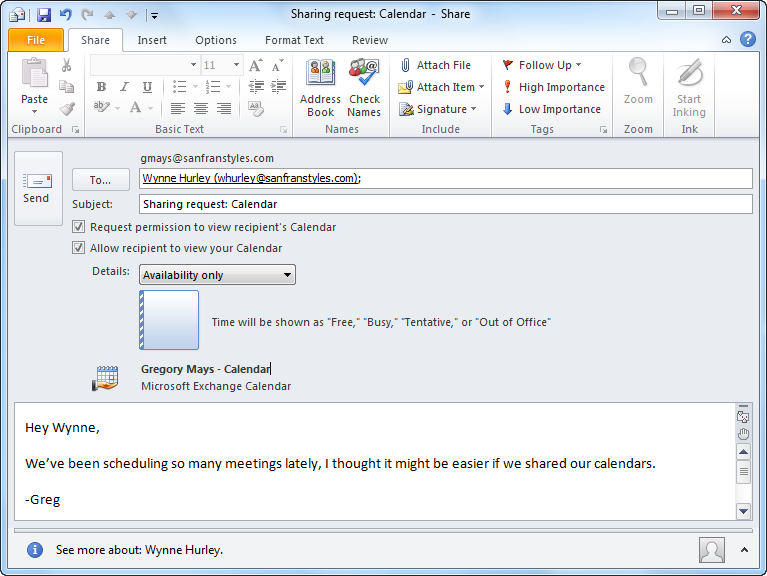Harmonizing Schedules: A Comprehensive Guide to Collaborating with Calendars in Outlook 2010

Introduction:
In the ever-evolving landscape of collaborative work environments, effective calendar management stands as a linchpin for successful coordination and productivity. Microsoft Outlook 2010, a stalwart in the realm of digital communication and productivity tools, offers a robust set of features designed to facilitate seamless collaboration through shared calendars. This extensive guide aims to provide a comprehensive exploration of collaborating with calendars in Outlook 2010, covering key functionalities, customization options, and advanced strategies to optimize group scheduling and streamline collaborative efforts.
Chapter 1: The Collaborative Power of Shared Calendars
- Overview of Shared Calendars: Establish a foundational understanding of shared calendars in Outlook 2010. Explore how shared calendars enable users to collaborate by providing visibility into each other’s schedules and events.
- Benefits of Collaboration: Delve into the benefits of collaborative calendar management. Understand how shared calendars enhance communication, coordination, and overall efficiency within teams and organizations.
Chapter 2: Sharing Your Calendar
- Setting Permissions: Master the art of setting permissions for sharing your calendar in Outlook 2010. Learn how to control the level of access others have to your schedule, including viewing, editing, or delegate permissions.
- Sharing Options: Explore the different sharing options available in Outlook 2010. Learn how to share your calendar via email, set up online sharing, or publish it to a shared location for broader accessibility.
Chapter 3: Viewing Shared Calendars
- Overlaying Shared Calendars: Understand how to overlay shared calendars with your own for a consolidated view. Learn how to manage multiple calendars and maintain clarity by toggling the visibility of shared calendars.
- Accessing Shared Calendars: Explore the process of accessing calendars shared by others. Learn how to subscribe to shared calendars and integrate them seamlessly into your own Outlook 2010 interface.
Chapter 4: Collaborative Event Scheduling
- Sending Meeting Requests: Master the art of sending meeting requests in Outlook 2010 for collaborative event scheduling. Learn how to propose meeting times, check attendees’ availability, and finalize meeting details.
- Responding to Meeting Requests: Explore the etiquette of responding to meeting requests. Understand the various response options, including accepting, declining, or proposing alternative meeting times, to facilitate efficient scheduling.
Chapter 5: Coordinating Team Activities
- Team Calendars: Delve into the concept of team calendars for coordinating group activities. Learn how to create and manage team calendars that provide a centralized view of events and deadlines.
- Group Scheduling: Explore advanced group scheduling features in Outlook 2010. Learn how to use the scheduling assistant to find suitable meeting times for multiple participants, minimizing scheduling conflicts.
Chapter 6: Customizing Calendar Views for Collaboration
- Agenda and List Views: Navigate between agenda and list views for calendars in Outlook 2010. Understand how these views enhance collaboration by providing a detailed, chronological overview of events and activities.
- Customizing Views for Teams: Explore customization options for calendar views tailored to collaborative efforts. Learn how to configure views that highlight team-specific events, deadlines, or milestones for improved coordination.
Chapter 7: Advanced Collaboration Strategies
- Using Calendar Groups: Harness the power of calendar groups for advanced collaboration. Learn how to organize and manage multiple calendars within groups to streamline visibility and coordination.
- Delegate Access: Explore the delegate access feature in Outlook 2010 for seamless collaboration within teams. Understand how to delegate calendar management tasks, allowing others to schedule and coordinate on your behalf.
Chapter 8: Mobile and Web Access for Collaborative Calendars
- Mobile Collaboration: Explore strategies for collaborating on calendars using mobile devices. Learn how to sync shared calendars with mobile devices and leverage collaborative calendar apps for on-the-go coordination.
- Web Access and Outlook.com Integration: Understand how web access and Outlook.com integration enhance collaborative calendar management. Learn how to access and coordinate shared calendars seamlessly across different platforms.
Chapter 9: Troubleshooting Collaboration Issues
- Common Collaboration Challenges: Address common challenges that may arise in collaborative calendar management. Explore troubleshooting tips for resolving issues related to permissions, synchronization, and visibility.
- Ensuring Data Accuracy: Prioritize data accuracy in collaborative calendars. Understand best practices for ensuring that shared calendars reflect the most up-to-date and accurate information for all team members.
Chapter 10: Calendar Security and Privacy in Collaboration
- Secure Calendar Collaboration: Prioritize calendar security in collaborative settings. Explore best practices for secure calendar collaboration, including managing permissions, controlling access, and protecting sensitive event information.
- Privacy and Data Protection: Explore privacy settings and data protection features in Outlook 2010 for collaborative calendar management. Learn how to balance transparency with privacy to foster effective collaboration.
Conclusion:
In conclusion, mastering the art of collaborating with calendars in Outlook 2010 is a pivotal skill that can significantly impact team efficiency and coordination. This comprehensive guide has equipped you with a thorough understanding of the tools, features, and strategies available in Outlook 2010 for effective collaborative calendar management.
Embrace the power of shared calendars, group scheduling, and advanced collaboration features to tailor Outlook 2010 to your team’s unique workflow. Whether you are a team leader, project manager, or a collaborative team member, the insights provided in this guide empower you to harness the full potential of Outlook 2010, fostering a culture of seamless coordination and productivity within your organization. By implementing these strategies, you can master the art of collaborative calendar management with confidence and elevate the efficiency of your collaborative endeavors.





